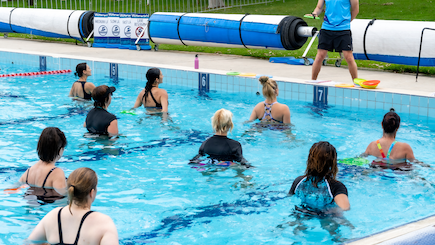Aqua fitness classes have gained immense popularity due to their numerous health benefits and low-impact nature. As an instructor, your role goes beyond teaching movements; you create an engaging environment that fosters participant satisfaction and improved health outcomes. This article will explore various strategies that aqua fitness instructors can employ when planning and teaching classes, ensuring a rewarding experience for participants.

Understanding Your Participants
Assess Group and/or Individual Needs – Before planning any aqua fitness class, gather information about your participants. Understanding their fitness levels, health conditions, and personal goals helps tailor your classes effectively. Conducting pre-class assessments through questionnaires or informal conversations can provide insights into their unique needs. For instance, some may be focused on weight loss, while others might seek rehabilitation or general fitness.
Create a Welcoming Environment – Ensuring participants feel comfortable is paramount. Foster a welcoming atmosphere by encouraging introductions and interaction. Establish a non-judgmental space where individuals of all fitness levels can feel safe to participate. Consider assigning partner exercises that promote camaraderie, allowing participants to bond and create a supportive community.
Class Structure and Planning
Set Clear Goals – Successful classes have clear objectives. Outline what you aim to achieve in each session, whether it’s enhancing cardiovascular endurance, building strength, or promoting flexibility. Clearly communicating these goals helps participants stay focused and motivated throughout the class.
Incorporate Variety and Equipment – Repetition can lead to boredom. To keep participants engaged, introduce a variety of exercises and techniques in your routines. Utilize different equipment like noodles, kickboards, or aqua dumbbells, and alternate between aerobic, strength, and flexibility activities. Consider themed classes (e.g., ‘Aqua Dance’ or ‘Aqua Boot Camp’) to maintain interest and enthusiasm.
Plan Progressions and Modifications – Recognizing that participants will have differing skill levels is essential. Ensure you have progressions for more experienced participants and modifications for beginners. This inclusivity enables everyone to work at their own pace while feeling challenged. For instance, offer progression options for squats or lunges—beginners may perform shallow movements, while advanced participants can engage in deeper dips.
Teaching Techniques
Use Clear and Effective Communication – Effective communication is essential in aqua fitness. Speak clearly and concisely, utilizing verbal and visual cues to guide participants through exercises. Consider demonstrating movements from the poolside beforehand, as visibility may be limited in the water. Reiterate important safety points regarding water depth and movement execution to prevent injuries.
Music, Rhythm and Timing – Aqua fitness is often choreographed to music, and the rhythm can significantly enhance the experience. Choose music that is motivating and aligns with the intensity of the workout. The right tempo can boost mood and energy levels, encouraging participants to push themselves harder while enjoying the process.
Emphasize Safety and Form – Safety should always be a priority. Remind participants to listen to their bodies and not push beyond their limits. Emphasize proper form to maximize the effectiveness of the exercises and minimize the risk of injury. Regularly circulate among participants to provide feedback and corrections, ensuring that everyone is maintaining correct posture and technique.
Engaging Participants
Foster Group Dynamics – Building a community within your class can elevate the participant experience. Encourage team activities or partner work, which can help create relationships among participants. Recognize accomplishments, whether small or large, to reinforce a sense of belonging and promote continuous motivation.
Solicit Feedback – Regularly ask for feedback about the classes you conduct. This could be done through informal discussions or post-class surveys. Understanding what participants enjoy or wish to improve doesn’t just boost class quality; it also demonstrates that their opinions matter, fostering loyalty and engagement.
Integrate Education – Incorporate elements of education into your classes. Take moments to provide participants with knowledge about the benefits of various exercises, tips for nutrition, or information regarding the health outcomes of regular aqua fitness. This added value reinforces their commitment to the program and promotes healthier lifestyle choices outside the class.
Health Outcome Considerations
Highlight Health Benefits – Articulate the benefits of aqua fitness during your classes. Share information about how regular participation can improve cardiovascular health, enhance flexibility, alleviate joint pain, or aid in weight management. By highlighting these health outcomes, participants may feel more inspired to commit to their fitness journey.
Monitor Progress – Encourage participants to track their progress to recognize their improvements over time. You can suggest that they maintain a fitness journal, record personal bests, or use wearable technology to monitor their workouts. Monitoring progress not only boosts motivation but also helps participants set realistic and attainable goals.
Address Emotional Health – Recognize that physical fitness is intricately linked with mental health. Create an encouraging atmosphere where participants feel positive and uplifted. Consider incorporating elements of mindfulness, such as deep breathing or relaxation techniques at the end of a class. Acknowledging the dual impact of fitness on physical and mental well-being can enhance engagement and satisfaction.
Conclusion – An effective aqua fitness instructor holds the power to significantly impact the participant experience and health outcomes. By understanding individual needs, planning thoughtful and varied classes, employing effective teaching techniques, fostering an inclusive environment, and emphasizing health benefits, instructors can create a rewarding atmosphere that elevates both participant satisfaction and fitness results. As the demand for aqua fitness grows, focusing on these essential strategies will ensure that you not only teach effectively but also inspire lasting wellness in your participants.
